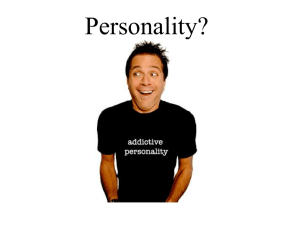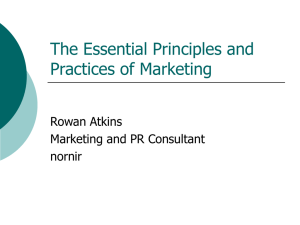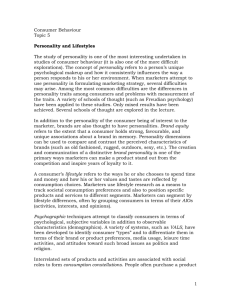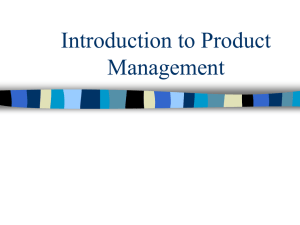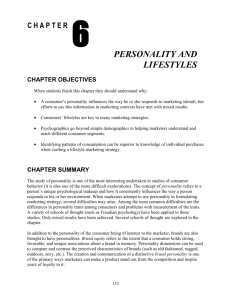Personality and Psychographics
advertisement
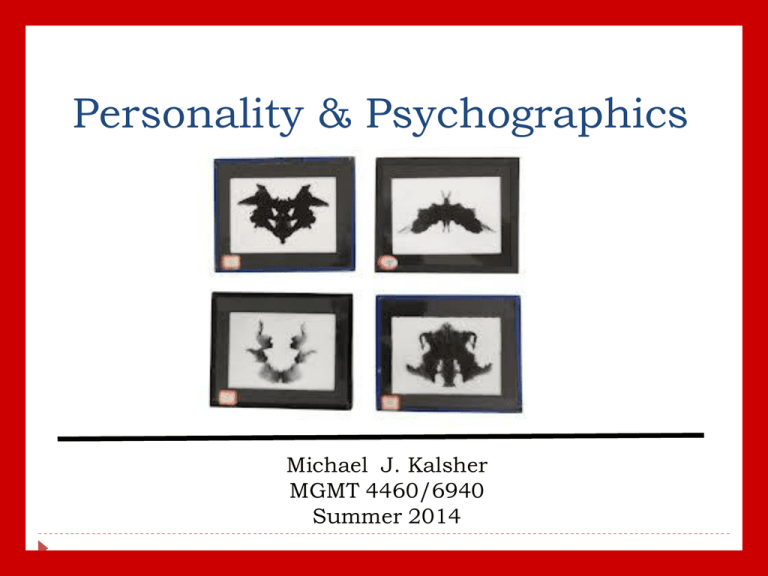
Personality & Psychographics Michael J. Kalsher MGMT 4460/6940 Summer 2014 Chapter Summary A consumer’s personality influences the way he or she responds to marketing stimuli. Consumers’ lifestyles are key to many marketing strategies. Psychographics go beyond simple demographics to help marketers reach different segments. Identifying patterns of consumption is superior to knowledge of individual purchases when a marketer crafts a lifestyle marketing strategy. Personality a person’s unique psychological makeup and how it consistently influences the way a person responds to his/her environment Freudian Systems Personality = conflict between gratification & responsibility Id Superego our conscience Ego pleasure principle mediates between id and superego Reality principle ego gratifies the id in such a way that the outside world will find acceptable Freudian Systems Product Symbolism and motivation The product stands for, or represents, a consumer’s true goal, which is socially unacceptable or unattainable. By acquiring the product, the person vicariously experiences the forbidden fruit. Motivational Research we channel socially unacceptable needs into acceptable outlets including product substitutes. What is Motivational Research? • • • A research approach that attempts to explain why consumers behave as they do. Assumes the existence of underlying or unconscious motives that influence consumer behavior. Attempts to identify forces and influences that consumers may not be aware of (e.g., cultural factors, sociological forces). • Typically, a person’s unconscious motives are intertwined with and complicated by his/her conscious motives, cultural biases, economic variables, and fashion trends (broadly defined). Views of Motivational Research Criticisms Invalid or works too well Too sexually based Appeal Less expensive than large-scale surveys Powerful hook for promotional strategy Intuitively plausible findings (after the fact) Enhanced validity with other techniques Neo-Freudian Theories Karen Horney Compliant vs. detached vs. aggressive Alfred Adler Motivation to overcome inferiority Harry Stack Sullivan Personality evolves to reduce anxiety Carl Jung Developed analytical psychology Carl Jung - Father of Analytical Psychology Disciple of Freud Established concept of collective unconscious (storehouse of shared memories we inherited from our ancestors) Explained the creation of archetypes (a universally recognized idea or behavior pattern) Old wise man Earth mother Y & R BrandAsset Valuator Archetypes – Healthy Personality Y & R BrandAsset Valuator Archetypes – Shadows to the Healthy Personality) Trait (as opposed to State) Theory Identifiable, relatively define a person. enduring characteristics that The Big Five Personality Traits Traits Relevant to Consumer Behavior Innovativeness Materialism Degree to which a person deliberately monitors and controls the image of the self that he or she projects to others Need for cognition Amount of emphasis a person places on acquiring and owning products Self-consciousness Degree to which person likes to try new things Degree to which a person likes to think about things and by extension, expends the necessary effort to process brand inform Frugality Tendency to deny short-term purchases and to make due with what they already own. Are You an Innie or an Outie? Idiocentrics Allocentrics (individualist orientation) (group orientation) Contentment More satisfied with current life Less satisfied with current life Health Consciousness Less likely to avoid unhealthy foods More likely to avoid unhealthy foods Food Preparation Spend less time preparing food Love kitchen; spend more time preparing food Workaholics More likely to work hard and stay late at work Less likely to work hard Travel and Entertainment More interested in traveling to other cultures Visit library and read more Problems with Trait Theory Prediction of product choices using traits of consumers is mixed at best Scales not valid/reliable Tests borrow scales used for mentally ill Inappropriate testing conditions Ad hoc instrument changes Use of global measures to predict specific brand purchases “Shotgun approach” (no thought of scale application) Brand Personality Set of traits people attribute to a product as if it were a person Brand equity: extent to which a consumer holds strong, favorable, and unique associations with a brand in memory—and the extent to which s/he is willing to pay more for the branded version of a product than for a non-branded (generic) version Nike Levi’s Brand personalities change over time A brand personality that stands out inspires loyalty Brand Behaviors & Possible Personality Trait Inferences Brand Action Trait Inference Brand is repositioned several times or changes slogan repeatedly Flighty, schizophrenic Brand uses continuing character in advertising Familiar, comfortable Brand charges high prices and uses exclusive distribution Snobbish, sophisticated Brand frequently available on deal Cheap, uncultured Brand offers many line extensions Versatile, adaptable Lifestyle Marketing Perspective People sort themselves into groups on the basis of: What they like to do How they spend leisure time How they spend disposable income What we buy makes a statement about what we believe to others Consumption Style Psychographics Use of psychological, sociological, & anthropological factors to: Determine market segments Determine reasons for choosing products Fine-tune offerings Even when consumers share the same demographic characteristics, they can still be very different people Psychographics When marketers combine personality variables with knowledge of lifestyle preferences, they have a much deeper level of insight into consumer segments. Examples: http://www.youtube.com/watch?v=0XdLheUC7kA&featu re=related http://www.youtube.com/watch?v=B42wbldDbcg http://www.youtube.com/watch?v=IAfGbsKtOSA Best Buy Psychographic Segments “Jill”: busy suburban mom who buys electronics for family “Buzz”: focused, active younger male interested in buying latest gadgets “Ray”: family “BB4B man who likes his technology practical (Best Buy for Business)”: small employer “Barry”: affluent professional male who’ll drop tens of thousands of dollars on a home theater system Forms of Psychographic Analysis Lifestyle profile (users vs. non-users) Product-specific profile (target group based on product related dimensions) General lifestyle study (places large sample of respondents into homogeneous groups based on similarities of preferences) Product-specific study (tailors questions to a product category) AIOs Grouping consumers according to: Activities Interests Opinions 80/20 Rule: lifestyle segments that produce the bulk of customers (20% of a product’s users account for 80% of the volume of product a company sells). Heavy users and the benefits they derive from product Good AND Bad (e.g., fast-food junkies; alcoholics) Lifestyle Dimensions Activities Interests Opinions Demographics Work Family Themselves Age Hobbies Home Social issues Education Social events Job Politics Income Vacation Community Business Occupation Entertainment Recreation Economics Family size Club membership Fashion Education Dwelling Community Food Products Geography Shopping Media Future City size Sports Achievements Culture Stage in life cycle Psychographic Segmentation Uses To define target market To create new view of market To position product To better communicate product attributes To develop product strategy To market social/political issues Value and Lifestyles System – VALS2TM Value and Lifestyles System Innovators successful consumers with many resources. Thinkers satisfied, reflective, and comfortable. Achievers career oriented and prefer predictability to risk or selfdiscovery. Experiencers impulsive, young, and enjoy offbeat or risky experiences. Believers strong principles and favor proven brands. Strivers similar to Achievers but have fewer resources. Makers action oriented and tend to focus their energies on selfsufficiency. Strugglers at the bottom of the economic ladder. Chapter Summary Consumer personality influences the way one responds to marketing stimuli Lifestyles are an important aid to many marketing strategies Psychographics go beyond simple demographics to help marketers understand different consumer segments Identifying patterns of consumption are valuable components of a lifestyle marketing strategy


